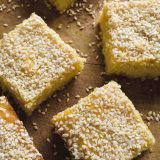Habib and Minerva Daoud, who own and run the restaurant Ezba in Galilee, have a theory of cooking they sum up as “give and take.” A cook gives water to rice, then takes it away with heat. This theory is just one of the things I love about this couple. They smile, they enjoy cooking, they enjoy each other, and their food is satisfying and deeply flavored.
After a morning of preparing a half dozen dishes, including maftoul (a form of couscous), hashweh (rice and meat) and freekeh (smoked green wheat), we sit down to a platter-filled lunch and end with a slice of hareesah. This is the everyday semolina cake of the Middle East, soaked in sugar syrup and topped with sesame seeds. Minerva bakes her version in a round pan, and it is denser and more clafouti-like than the standard recipe. It’s delicious.
A few days later at the restaurant Igra Rama in Tel Aviv, I am served hareesah once again, this time lighter and more cake-like, the sort of thing that would be at home at any coffee klatch here in the U.S.
Since hareesah is made differently across the Middle East, back at Milk Street our kitchen had plenty of sources of inspiration to choose from. Semolina flour is not optional; in our recipe yogurt, tahini, cornmeal and coconut are the other key ingredients (the latter two clearly not traditional). We toasted the dry ingredients in butter to start, which added depth. The sugar syrup was flavored with honey and lemon zest; orange flower water is optional, but a common ingredient in the region.
There is nothing wrong with pound cake or the Italian ciambella, but hareesah offers many layers of flavor, showing off its rich Middle Eastern roots. It’s stiff competition for even a great cup of coffee.
When flour is heated, the starches break down to glucose, which then caramelizes. The glucose also reacts with proteins in the butter to produce deeper flavor than caramelization alone.




